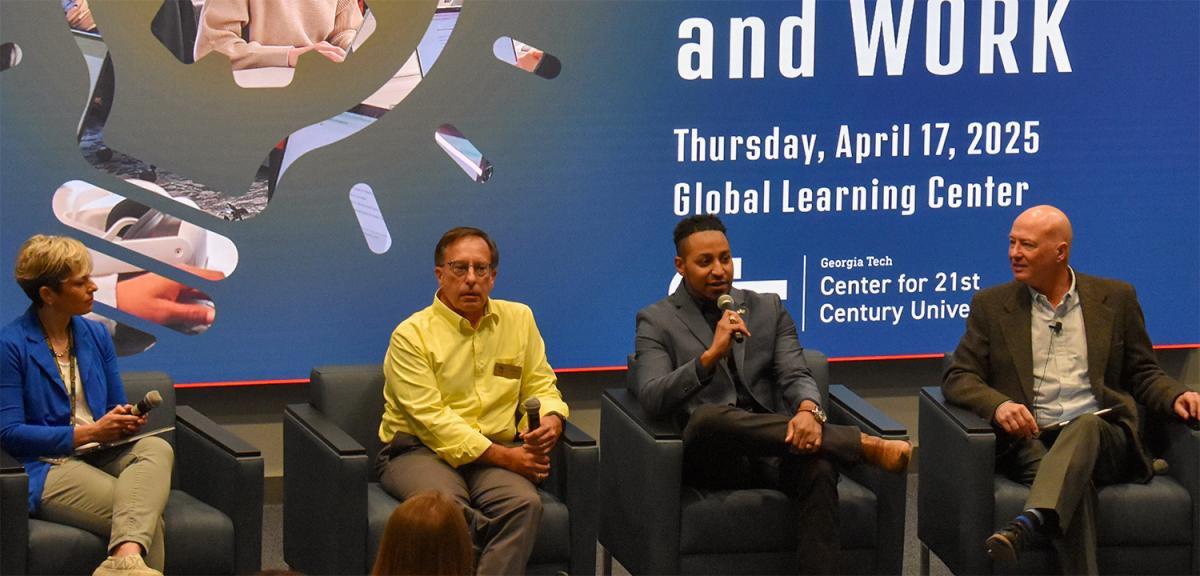
AI in Manufacturing: Key Insights from Industry Experts
The panel “AI in Manufacturing” opened the recent C21U symposium “Inventing the Future of Learning and Work.” Moderated by C21U Executive Director Stephen Harmon, the panel brought together industry leaders, including GTPE Project Management Academic Program Director Chris Carter, Assistant Director of the Center for Economic Development Research Leigh Hopkins, and Georgia Tech AI Academic Program Director Tim Brown to discuss the current state and future trajectory of artificial intelligence in the sector. The panelists shared their perspectives on how AI is transforming manufacturing processes and the workforce.
Current State and Future of AI in Manufacturing
Tim Brown began the discussion by emphasizing the broad scope of AI, which includes robots, drones, and computer vision. While AI technologies like ChatGPT have gained prominence recently, traditional AI applications in manufacturing have been around for a long time. "We're going to see more robotics and a lot of complex physical tasks of manufacturing," Brown said, highlighting the growing importance of AI in addressing labor issues and enhancing robotic process automation.
Chris Carter illustrated practical applications of AI on the manufacturing floor, describing how modern assembly factories already use AI-enabled robots for tasks like part picking. He explained how this can evolve to preventive maintenance on robots and industrial equipment. "Preventive maintenance requires a lot of workforce, but it can be learned because it is cyclical. If AI could learn this information and run an oil change on a chiller, for example, that would greatly change the game," Carter explained, highlighting the transformative potential of AI.
Leigh Hopkins brought attention to the challenges faced by smaller manufacturers in adopting AI. She mentioned the Georgia Manufacturing Extension Partnership (MEP), which helps small and medium-sized manufacturers implement AI affordably and understand its implementation. While she acknowledged the concern about the potential gap between large and small manufacturers due to AI adoption, she expressed optimism that programs like the MEP could help bridge this gap by bringing the technology to them and demonstrating its practical applications.
Impact on Workforce and Training
The impact of AI on the workforce was a significant topic. Tim highlighted the role of AI in training, particularly through XR, AR, and VR technologies. He shared a personal anecdote about learning to make Cheetos 40 years ago, contrasting on-the-job verbal training methods with modern virtual ones. "Nowadays, you can learn in an XR environment, the whole operation being virtual, before working on a physical scenario," Tim said, illustrating how AI can make training more effective and less intimidating. He added that on the professional side, AI can help with many tasks. “I believe AI will help physical and professional workers become problem formulators and solvers,” he said.
Chris noted that AI can save professionals time by automating tasks like change management by assisting in implementing updates, creating reports, and other tasks. While there are some limitations, AI as a tool to improve an organization provides the professional side of the house with opportunities to be more creative and innovative.
Leigh added a poignant perspective on AI's lack of emotional intelligence. She shared a conversation with her son, who remarked, "I can feel," when asked what he could do that AI couldn't. With this, she emphasized the importance of creativity and emotional intelligence in the workforce, suggesting that AI could complement rather than replace human skills.
Human Augmentation and Collaboration
Tim shared an automotive supplier's example of a practical approach to integrating AI into manufacturing without reducing the human workforce. The company uses AI-enabled robots for high-volume tasks while humans handle slower-moving items. "They haven't invested all their funds in robots to handle the slow movers. They've made a balanced capital expenditure, a human AI augmentation type balance," he explained.
Leigh and Chris discussed the skills needed for effective collaboration with AI. Chris highlighted prompt engineering and human machine learning as essential skills, while Leigh emphasized the importance of creativity and comprehension. "You could have somebody come into a manufacturing facility, and they can take an engine apart and put it back together. But can they write an assessment?" Leigh asked, underscoring the need for higher-level thinking and communication skills.
The future of education in manufacturing and other fields was also discussed. Tim proposed integrating AI into education to tailor learning paths to individual needs. Leigh likened education to building blocks in Minecraft, where students create unique skill sets through various certifications and training programs. "I think it will be very individualized and unique," Leigh said, highlighting the need for flexible and personalized education approaches.
Advice for Aspiring Manufacturers
Tim advised young people considering a manufacturing career to be systems thinkers, “Think not just narrowly of an individual cell or individual process, but think about how you're part of a team producing a good, and enjoy that,” he said. Leigh added that manufacturing is not the dirty, dingy workplace it once was. "You can still bring your creativity and your feelings to your work," she emphasized, highlighting the evolving nature of the manufacturing industry. Finally, Chris sees manufacturers as value creators, “You should see yourself as a world changer because you're creating value even if your job seems small, you're part of something larger,” he said.
The panel provided valuable insights into AI's transformative role in manufacturing, highlighting both opportunities and challenges. As AI continues to evolve, the industry must adapt to harness its full potential while ensuring a balanced and inclusive approach to workforce development and education.
(text and background only visible when logged in)